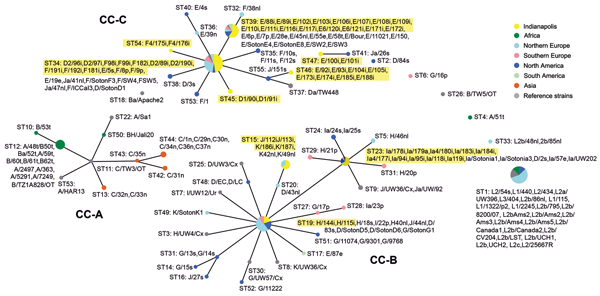Volume 20, Number 11—November 2014
Research
Novel Chlamydia trachomatis Strains in Heterosexual Sex Partners, Indianapolis, Indiana, USA
Figure 1

Figure 1. Population snapshot for Chlamydia trachomatis samples collected during April 2000–October 2003 from members of heterosexual partnerships (dyads) in Indianapolis, Indiana, USA, compared with reference strains. Data were compiled in eBURST (http://www.mlst.net). Three distinct clonal complexes (CCs) are shown, along with numerous singletons of various sizes and 1 doublet. CC-A, strains causing trachoma; CC-B, noninvasive, nonprevalent urogenital strains; CC-C, noninvasive, globally prevalent urogenital strains. Samples from Indianapolis are highlighted in yellow (shown with sample identification number) and are restricted to clusters I and III. Each circle represents a sequence type (ST) at the point where linked STs within each CC are likely to have descended from the same recent ancestor. The area of the circle denotes the number of samples for that ST. The primary founder of the CC is at the hub; subgroup founders are represented as secondary hubs (e.g., C/35n).
1These authors contributed equally to this article.